Completion of the Clinton and Illinois High Bridge
1892 A Great Work Finished
From: The Clinton Daily Age; Sunday, September 11, 1892, P.1
Transcribed by a Clinton County IaGenWeb volunteer.
COMPLETION OF THE CLINTON AND ILLINOIS HIGH BRIDGE.
ONE OF THE FINEST BRIDGES ON THE MISSISSIPPI.
BUILT AT A COST OF $150,000 – CLINTON AND ILLINOIS UNITED.
A GREAT EVENT IN THE HISTORY OF CLINTON.
BEGINNING AND COMPLETION OF THE WORK.
SOME NOTABLE EVENTS – MATERIAL USED IN ITS CONSTRUCTION – TOLLS TO BE CHARGED –
BRIDGE REVENUE –ETC.
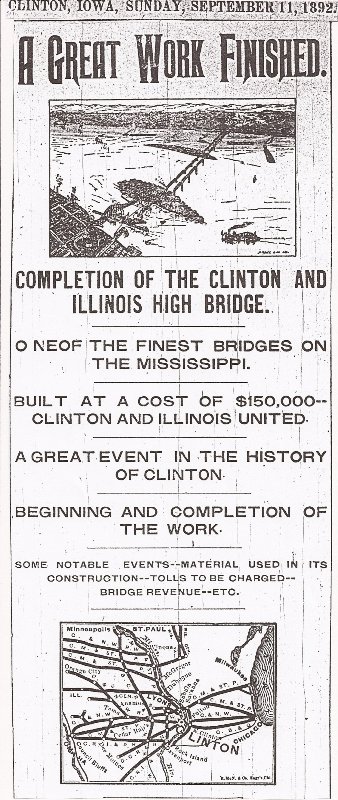 The history of the Clinton high bridge, if written, would be not only ht history
of Clinton for more than twenty years, but would embrace the biography of many
of its most enterprising citizens. Some enthusiastic workers sleep by the hill
side, but their labors speak today in trumpet tones in recognition of their
faithful, zealous services in forwarding Clinton’s material interests. Peace be
theirs, now and ever more.
The history of the Clinton high bridge, if written, would be not only ht history
of Clinton for more than twenty years, but would embrace the biography of many
of its most enterprising citizens. Some enthusiastic workers sleep by the hill
side, but their labors speak today in trumpet tones in recognition of their
faithful, zealous services in forwarding Clinton’s material interests. Peace be
theirs, now and ever more.
There was talk about a wagon bridge as far back as 1870. The subject was being
continually agitated, public meetings were held to consider some particular
plan, and every effort that a pushing, energetic, rustling community could
devise was from time to time put forth to secure better facilities for crossing
the river.
In the month of January, 1872, the C. B. & Q. R. R. Co., organized in this city
a bridge company, to build a railroad bridge at this point. While the
organization was being perfected in the parlor of the Clinton National Bank, Mr.
W. F. Coan, always ready to push every enterprise which promised to help the
growth of Clinton, suggested that the articles of incorporation provide for a
wagon bridge in connection with a railroad bridge. This suggestion met with
considerable opposition on the part of the C. B. & Q. officials, but it was
finally adopted, and after several months of hard effort and a good deal of
expensive lobbying, a charter was procured from congress. This was in the summer
of 1872. Afterwards the charter was so amended as to permit the building of a
pontoon, which at one time was all the rage at different points on the river.
The C. B. & Q. commenced its bridge. The approach on the Illinois side to the
present wagon bridge was built by that company. A few piles were driven in the
river, W. J. Young & Co. were notified to move their lumber which was stored on
the line where the bridge was to touch the Iowa shore, the right of way was
partly procured through the city where the Burlington, Cedar Rapids & Northern
road now runs. The city entered into a written contract to pay the C. B. & N.
some seven or eight thousand dollars per year to build the bridge so it could be
used for teams. But the bridge was not built. The reason does not figure in this
brief history.
In an editorial published in the AGE on December 19, 1873 the editor suggested
that Clinton join forces with Dubuque and procure a charter for both points. At
that time the AGE said:
“True our ferry is just being put into a good condition for active operations,
yet C. Lamb & Sons, the proprietors of the new ferry would take as much stock in
a wagon bridge over the river as any other firm in the city. Their interests
here are too great to allow a mere ferry to stand between them and the building
of a bridge.”
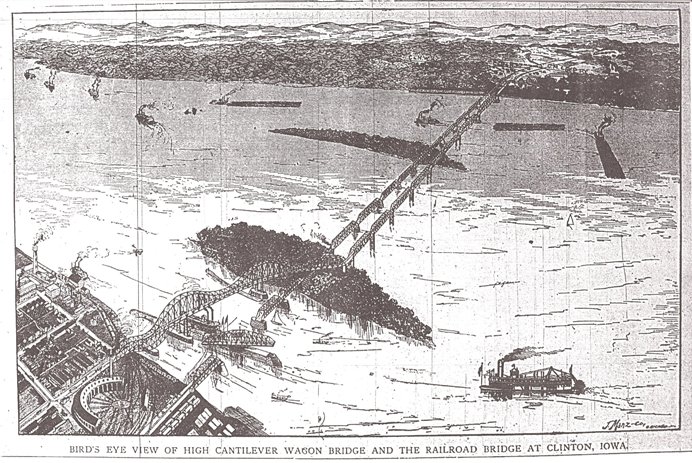 All the papers in the city kept pounding away at the bridge. The efforts to
cooperate with Dubuque fell through, and in fact no progress was made in
reaching a plan for building the bridge, though the subject was kept uppermost
in the people’s minds. October 27, 1876 the AGE said: “But we have no farther
plea to make in behalf of this project. We have hammered away at it until all
Clinton is tired of the noise. Occasionally when we can find a pretext for it,
we make a few blows to wake the people up. If anyone gets mad at the uproar, we
will give him a soporific pill which may put him to sleep again.”
All the papers in the city kept pounding away at the bridge. The efforts to
cooperate with Dubuque fell through, and in fact no progress was made in
reaching a plan for building the bridge, though the subject was kept uppermost
in the people’s minds. October 27, 1876 the AGE said: “But we have no farther
plea to make in behalf of this project. We have hammered away at it until all
Clinton is tired of the noise. Occasionally when we can find a pretext for it,
we make a few blows to wake the people up. If anyone gets mad at the uproar, we
will give him a soporific pill which may put him to sleep again.”
Every conceivable argument that could be thought of was used to bolster up the
bridge project. The newspapers did not propose the thing should die. It came to
be a second nature to them to say something about the bridge. When there was no
other subject to discuss the bridge question caught it.
So the thing drifted along year after year until steps were taken which resulted
in the consummation of this great enterprise.
In the spring of 1887 the Clinton & Illinois Bridge Company was organized, the
following named persons being the incorporators and also declared the directors
until January 1st, 1888 – John W. Pollock, Thos. J. Price, P. S. Towle, Edward
H. Thayer, C. E. Armstrong, C. C. Coan, W. J. Young, Jr., M. D. White, C. E.
Baldwin, Chas. Arlen, A. E. Smith, A. L. Schuyler and A. R. McCoy.
In the winter of 1888 steps were taken to procure from congress a charter for a
railroad and wagon bridge. The bill was passed but in such a way as to
necessitate further legislation. The matter was put in the hands of Congressman
Hayes, and in due time the charter was granted as desired.
It became necessary to secure certain state legislation in order that the city
might vote a tax to be used in building a bridge a part of which would be in
another state. A general law was passed at the instance of the Clinton company,
and under that law Muscatine built its bridge.
Subsequently Mr. Pollock who had served as president in a most acceptable manner
resigned because his business required his time in the south, and Mr. W. J.
Young, Jr., was elected his successor. Other changes were made in its board of
directors, the persons serving during the construction of the bridge and now the
members being –
W. J. Young, Jr., Pres.
A. L. Schuyler, Sec.
C. C. Coan, Treas.
P. S. Towle.
E. H. Thayer.
J. K. Sweeney.
A. R. Olney.
Frank Thornburg.
A.L. Stone
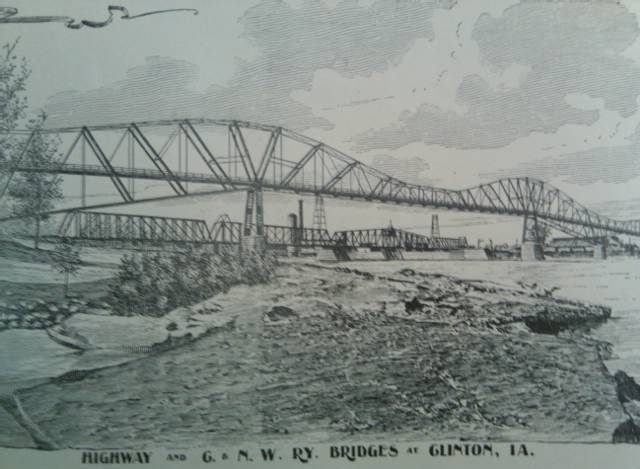 On the 25th day of May, 1889, the city council having had submitted to it a
petition containing the required number of names, ordered an election on the
11th day of June on the question of voting a five percent tax in aid of the
bridge. The notice of election as prepared by the city council set forth fully
the terms upon which the tax should be passed over to the bridge company, in
case it was voted. The conditions as regards the tolls being as follows:
On the 25th day of May, 1889, the city council having had submitted to it a
petition containing the required number of names, ordered an election on the
11th day of June on the question of voting a five percent tax in aid of the
bridge. The notice of election as prepared by the city council set forth fully
the terms upon which the tax should be passed over to the bridge company, in
case it was voted. The conditions as regards the tolls being as follows:
BRIDGE TOLLS.
First. Said company or assigns shall not charge as tolls for passage and travel
over said bridge, to exceed the following rates:
For the passage of a double team either way or for round trip the same day or
within two successive days – 25c.
Single team or buggy either way, or for round trip the same day or within two
successive days – 25c.
Led horses or cattle one way, per head – 10c.
Driven sheep or swine per head – 5c.
Foot passengers each way – 5c.
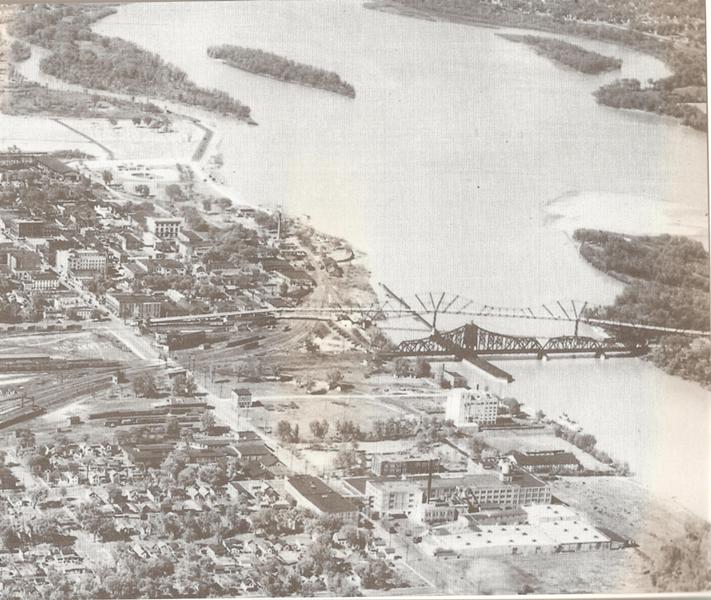 Omnibuses or hacks carrying passengers for hire, five cents for each passenger
each way, in addition to the above rates for like teams, which rates of toll
shall not be increased for the term of two years next succeeding the completion
of said bridge; at which time, if it shall transpire that the revenues derived
thereby are less in amount than eight per cent of the actual paid up capital
subscribed to the capital stock of said company, and the interest on the bonds
for which said improvement and bridge may be bonded, which interest shall not
exceed eight percent, then the rates of toll may be advanced so as to realize
eight per cent, but in no event shall said tolls exceed twice the above amounts.
But whenever the net revenues of said bridge are sufficient to more than pay the
repairs or improvements necessary to be made within one year, and expenses,
interest on bonded debt, and eight percent on the actual paid up stock
subscriptions, then the tolls on said bridge shall be reduced pro rata on above
charges so as not to exceed such limits of tolls first specified.
Omnibuses or hacks carrying passengers for hire, five cents for each passenger
each way, in addition to the above rates for like teams, which rates of toll
shall not be increased for the term of two years next succeeding the completion
of said bridge; at which time, if it shall transpire that the revenues derived
thereby are less in amount than eight per cent of the actual paid up capital
subscribed to the capital stock of said company, and the interest on the bonds
for which said improvement and bridge may be bonded, which interest shall not
exceed eight percent, then the rates of toll may be advanced so as to realize
eight per cent, but in no event shall said tolls exceed twice the above amounts.
But whenever the net revenues of said bridge are sufficient to more than pay the
repairs or improvements necessary to be made within one year, and expenses,
interest on bonded debt, and eight percent on the actual paid up stock
subscriptions, then the tolls on said bridge shall be reduced pro rata on above
charges so as not to exceed such limits of tolls first specified.
Second. All conditions precedent shall be complied with before any money is paid
to said company or assigns by the county treasurer, and when so paid it shall be
upon the order of the president or a majority of the directors of such company.
Third. The treasurer or officers of the bridge company shall upon the completion
of said bridge make full report of the costs of construction and repairs
thereof, and shall annually on the first day of January make report of the
receipts and expenditures of said bridge to said city, and the books of the
company shall be open at all times for inspection by the mayor and auditor, or
such person as the city council may direct.
Fourth. The bridge shall be open for passengers twenty-four hours each day,
except when necessarily closed for repairs or by reason of accident.
Fifth. It shall be exempt from taxation.
 Sixth. The said city of Clinton may at its option and election, purchase of the
Clinton and Illinois Bridge Company and its assigns, the said bridge so erected,
at the expiration of ten years from the date of its completion, or at any ten
years period thereafter, upon paying to said company or its assigns, the amount
of actual cash capital invested therein, exclusive of the amount received from
said tax. And in the event that the revenues derived from said bridge shall not
have been sufficient to pay said company, after deducting necessary repairs and
interest upon bounded indebtedness as aforesaid, an amount equal to eight per
cent, computed annually upon the actual cost of said bridge, exclusive of the
amount realized from said tax, and the bounded indebtedness of said company,
then said city to pay to said company such additional amount as may be necessary
to make the net revenue as aforesaid equal to eight per cent per annum, computed
annually, from the date of expenditure to the date of purchase by said city.
Sixth. The said city of Clinton may at its option and election, purchase of the
Clinton and Illinois Bridge Company and its assigns, the said bridge so erected,
at the expiration of ten years from the date of its completion, or at any ten
years period thereafter, upon paying to said company or its assigns, the amount
of actual cash capital invested therein, exclusive of the amount received from
said tax. And in the event that the revenues derived from said bridge shall not
have been sufficient to pay said company, after deducting necessary repairs and
interest upon bounded indebtedness as aforesaid, an amount equal to eight per
cent, computed annually upon the actual cost of said bridge, exclusive of the
amount realized from said tax, and the bounded indebtedness of said company,
then said city to pay to said company such additional amount as may be necessary
to make the net revenue as aforesaid equal to eight per cent per annum, computed
annually, from the date of expenditure to the date of purchase by said city.
Seventh. A majority of the board of directors of said Clinton and Illinois
Bridge Company or its assigns shall always be residents of said city of Clinton.
SPECIAL ELECTION.
On May 28, 1889, Mayor Chase called a special election of the legal and
qualified voters of the city of Clinton to vote upon the question of aiding the
Clinton and Illinois Bridge Company. The election was held June 11, 1889, and
resulted in a majority of 921 in favor of the bridge tax. The stock subscription
books of the bridge company were opened on Friday, June 14, 1889, and at 3
o’clock on Monday, June 17, the last share was taken.
The next morning after the election the AGE published the following editorial
which today will be found very interesting reading:
921.
Magic figures are these. They are the figures which mark the commencement of a
grand era of prosperity for Clinton.
After a warmly contested election the citizens of Clinton say they are in favor
of a bridge over the Mississippi river. They say it with emphasis, and even
those who did not say so at the polls, cheerfully acquiesce in the will of the
majority.
This is but the commencement of the end. It is the injection of new blood into
Clinton’s veins. It was the one thing needed to lift Clinton out of the rapidly
growing rut it was in. It came in the nick of time to give the city an
opportunity to tell the world that there was no better locality in the valley of
the upper Mississippi for the investment of capital that would give employment
to labor than Clinton.
A high bridge to cost $175,000 to be built.
 The most important business thoroughfares of the city being paved with brick.
The most important business thoroughfares of the city being paved with brick.
More than five miles of additional mains being laid by the Water Works Company.
The extension to the bluffs of the street railway.
An extensive pork and beef packing house about to be established.
All these things are new things. They are the things which tell the outside
world the story of Clinton’s enterprise and grit.
Capital likes a place where there is a large amount of get up and get. It likes
a place that can show good reasons for expected growth. Capital can’t help
liking Clinton if it will only come and look Clinton over.
The AGE don’t claim that there is a boom on. It claims for Clinton all that
booms can do and that too without a boom.
There is nothing ephemeral about Clinton. It has not come up in a day to go down
in a month. Its growth has been steady and substantial, and in non manner
speculative.
Its manufactories are all prospering. Its railroads are the great trunk lines
which are rapidly transforming the wilderness into a garden. It is tributary to
as rich a soil and as highly cultivated as the west affords. In a word it is a
live city and it wants capital to come and engage in business.
That it is a live city there need be no better evidence produced than the fact
that it has just voted upon itself a tax of five percent on its assessed
valuation as an outright donation in aid of the construction of a wagon bridge
over the Mississippi river.
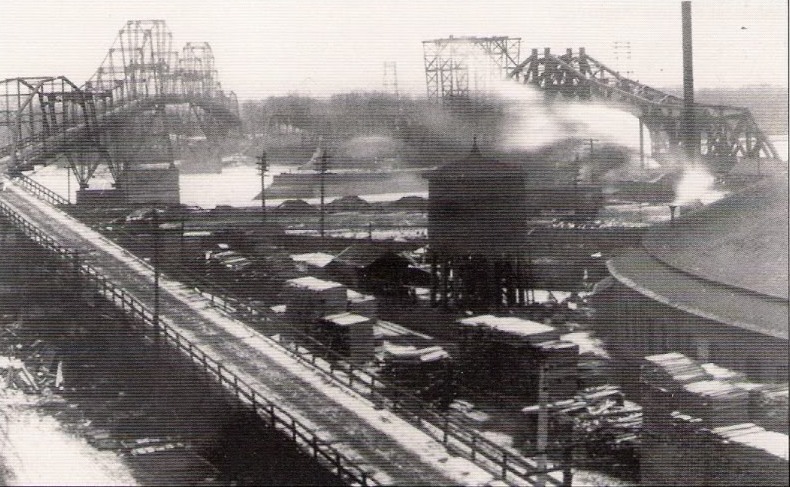 It is a princely donation made by a generous spirited people. It is a donation
made by a people who believe it will be returned tenfold in the speedy growth of
the city and in the new traffic such an improvement will create.
It is a princely donation made by a generous spirited people. It is a donation
made by a people who believe it will be returned tenfold in the speedy growth of
the city and in the new traffic such an improvement will create.
Nothing goes so far or counts so much with capital seeking investment in
manufactures as to know that the people among whom it proposes to locate have
confidence in the growth and prosperity of their city. A people may say they
have. They may organize their Boards of Trade and pass resolutions declaring in
emphatic terms their belief that the future has grand things in store for them.
They may send out statistics showing year by year the growth of population and
trade. They may present to capital all the arguments imaginable to induce it to
establish new industries. And capital may turn a deaf ear to all because those
things have come to be familiar tales.
But tell them a city of 17,000 inhabitants has voted a donation outright of
$100,000 to aid a single enterprise, and capital pricks up its ears, stretches
its neck, opens wide its eyes, and takes the cotton out of its ears. Those are
magic figures. They mean something. They talk. Capital listens, and on such
evidence of a people’s confidence in the future of their town, capital acts.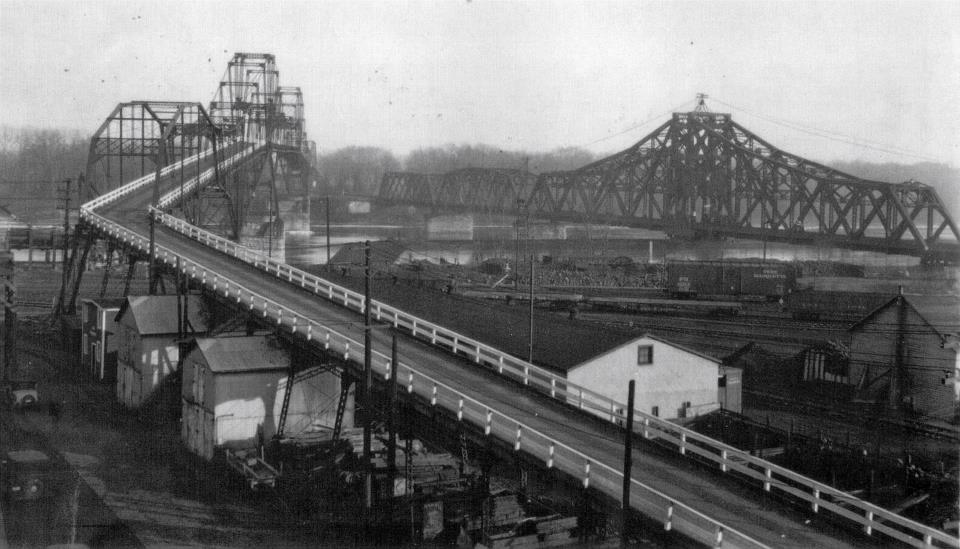
The AGE congratulates the people of Clinton on the wisdom they have exhibited in
voting this tax. We do not believe any of those who voted against it will regret
that the tax carried.
THE FIRST WORK.
The first actual work on the construction of the bridge was done on the 8th day
of September, 1890. On the day Mayor Gobble and a delegation of prominent
citizens went to Little Rock Island where the first pile was driven with fitting
ceremonies.
On this occasion Hon. H. W. Seaman introduced E. H. Thayer, editor of the AGE,
who after a few brief remarks regarding Clinton’s past and future suggested that
Mayor T. M. Gobble drive the first pile. Amid loud applause Mr. Gobble’s hands
set in motion the machinery, the heavy hammer fell from the top of the derrick,
striking the first pile at 5:07 p. m. , just as the C. & N. W. passenger train
from Chicago passed over the railroad bridge.
MASONRY, PILES AND IRON.
The following figures giving the amount of iron and masonry employed in the
construction of the bridge, are as near accurate as it is possible to obtain
them:
2,350 yards of masonry.
660 piles.
500 cubic yards concrete.
2,500 yards of riprap.
130,000 pounds of iron columns.
1,800,430 pounds of iron superstructure.
Iron approach Eighth avenue (trestle) 480 feet.
Iron approach on island (trestle) 280 feet.
First span 170 feet.
Cantilever (clear space, 420 feet) 1,108 feet.
Total cantilever system, 1,398 feet.
Six spans east channel, 150 feet each, 700 feet.
First span east channel 220 feet.
Filling at Eighth avenue 200 feet.
Trestle on Illinois side, 1,700 feet.
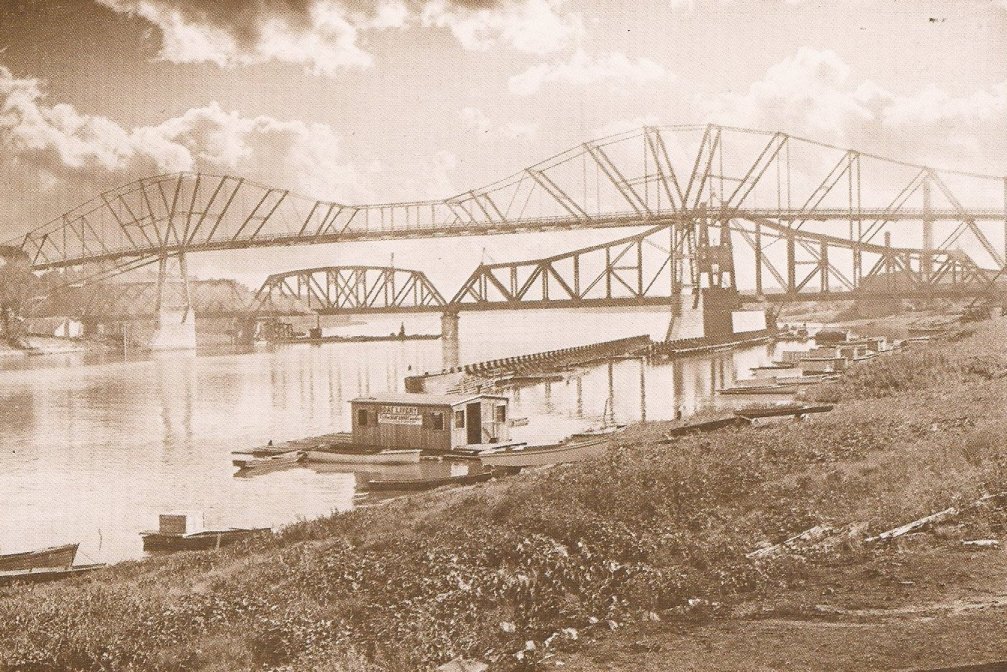 LUMBER, NAILS AND MEN.
LUMBER, NAILS AND MEN.
In the construction of the bridge half a million feet of lumber and twenty
thousand pounds of nails were used. The floor of the bridge is constructed of
three-inch planks spiked onto a dozen four-by-ten inch stringers.
During the construction of the bridge an average of thirty-five men have been
employed on the work at this point. There has been times when between two and
three hundred men were engaged on the iron work at the shops in Pittsburgh, Pa.
BRIDGE REVENUES.
Frequently the question has been asked: “Will the bridge pay?” The AGE can see
no better way of answering this question than by giving the amount of revenues
derived from the wagon bridge at Keokuk from the year 1879 to 1888 inclusive.
The country contiguous to the Illinois end of the Keokuk bridge compares very
favorably with the east end of the Clinton bridge, being given up almost
exclusively to farming. During the year 1879 the Keokuk bridge received from
highway traffic $15,500; 1880, $15,000; 1881, $16,500; 1882, $13,500; 1883,
$14,000; 1884, $14,500; 1885, $14,200; 1886, $14,000; 1887, $14,900; 1888,
$14,500. The toll rates over the Keokuk bridge are: Two horse vehicles, 25c.;
one horse vehicle, 20c.; lead animals, 15c; footmen, 5c. each way.
BRIDGE NOTES.
The bridge was built at a cost of $150,000.
Ira Johnson was the superintendent of construction.
The work was done under the supervision of Geo. T. Baker, C. E., of Davenport.
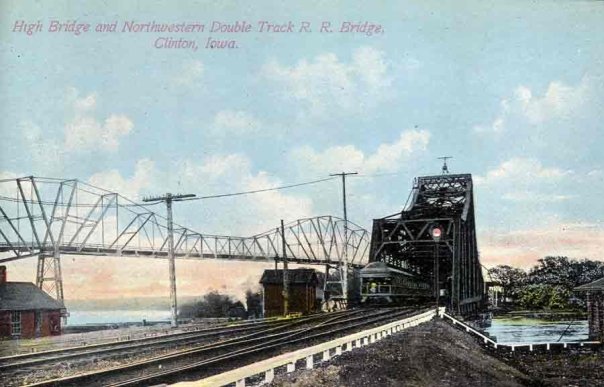 The contract for the iron and construction was given to the Clinton Bridge &
Iron Co.
The contract for the iron and construction was given to the Clinton Bridge &
Iron Co.
The bridge will probably be opened for traffic during the present week, or as
soon as it is accepted by the bridge company.
At 1:15 o’clock on Thursday, August 18, the last bolt was driven into place
which tied both ends of the cantilever span of the bridge together, this honor
falling to Frank Robinson, a popular employee of the bridge company, who had
also driven the first pin over a year ago.
The highest point on the bridge is the cantilever span over the west channel. It
is fifty-five feet above high water mark and seventy-six feet above low water
mark.
The first team to cross the bridge after the planking had been completed was one
of C. Lamb & Sons’ mill teams with a load of planks which were brought over from
the Illinois side.
The most serious accident to occur during the construction of the bridge was in
June last, when a severe wind storm toppled over the traveler on the east side
of the channel, entailing a loss of about $500. In July one of the workmen on
the bridge fell into the river, but escaped without serious injury.
BRIDGE POETRY.
When the Lyons bridge was completed all that was visible of the Clinton
structure was the first piling driven. In a spirit of ridicule and false
prophecy, presumably prompted by a hope it would prove true, a Lyons bard penned
the following machine verse, which the Mirror published and by request the AGE
reproduces it at this time, just for fun, and as a chestnut adjusted to this
AGE:
We stood on the Lyons and Fulton bridge.
And the day had hardly begun;
We watched the streams of wagons that passed
With hundreds more to come.
As we stood there we gazed on a populous scene:
Two magnificent cities we claim;
And I showed them far off the westward
A village, “South Lyons” by name.
We spoke of the former trials of the bridge
And its wonderful history;
Of the doubting people with so few men
To lead – ‘em to victory.
But now the Stock-well has been taken;
The two dry goods merchants are gay,
For the farmer and Gardner brings over his crops
And takes Lyons goods back in pay.
We scanned the distant horizon;
On the muddy Illinois shore
Stood a solitary pine wood stick,
A relic of those flush days of yore.
For this was the end of the newspaper bridge
The Keepers of the bridge stock went west
Though Gobble had driven this pile for a bridge,
Bluff and blow could not build up the rest.
I show them a moral now to my tale:
For the Root of all success is grit,
Though grumblers may growl and re-Joice to howl,
Good citizens “git up and git.”
The AGE simply answers, Amen.
Clinton Daily Age, Sunday, September 11, 1892, P.2
THE BRIDGE.
 Again we say too much importance cannot be attributed to the completion of the
wagon bridge. Ordinarily the opening to traffic of such an improvement would be
celebrated in the noisiest and most elaborate manner. But Clinton is none the
less demonstrative in feeling because of no grand outward display of enthusiasm.
Fourth of July was honored in this city as never before, and it was understood
at the time that the coming of the big bridge was one of the chief events to
then rejoice over. When the preparations were first set on foot to do the right
thing in honor of the nation’s birthday it was thought the bridge might be
completed so as to be thrown open to the public on that occasion. But continued
obstacles in the way of procuring the material for the great cantilever span so
delayed the work that it was thought best not to hurry it, so only in prospectus
was the completion of the great undertaking celebrated.
Again we say too much importance cannot be attributed to the completion of the
wagon bridge. Ordinarily the opening to traffic of such an improvement would be
celebrated in the noisiest and most elaborate manner. But Clinton is none the
less demonstrative in feeling because of no grand outward display of enthusiasm.
Fourth of July was honored in this city as never before, and it was understood
at the time that the coming of the big bridge was one of the chief events to
then rejoice over. When the preparations were first set on foot to do the right
thing in honor of the nation’s birthday it was thought the bridge might be
completed so as to be thrown open to the public on that occasion. But continued
obstacles in the way of procuring the material for the great cantilever span so
delayed the work that it was thought best not to hurry it, so only in prospectus
was the completion of the great undertaking celebrated.
But the work is now finished. The beautiful structure spans the Father of Waters
at our very doors. As a work of art and mechanics, it is a grand success. As a
thoroughfare over which the traffic of a portion of two states shall be
accommodated it must prove in the highest degree beneficial.
The AGE has repeatedly discussed the nature of the benefits this city will
derive from the bridge. But the benefits are by no means all on the Iowa side of
the river. On the contrary they are as important to the people of that part of
Illinois conveniently accessible to this city as they are to Clinton.
The great desire of every industry is a market. The more markets the better for
the producer. The easier and cheaper the market is reached the greater the
benefits to be derived by both producer and consumer. This wagon bridge makes it
easy and convenient for a large territory of farming country and a large
population of people engaged in various avocations, to reach a market heretofore
in a great measure closed to them.
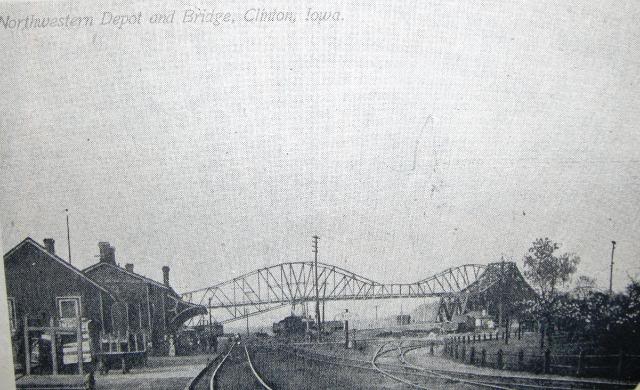 The increased farm trade which the bridge will bring hither must lead to the
establishment in Clinton of market places provided with means to engage largely
in purchasing every description of farm product. There may be a healthy
competition created, but there is no danger of its reaching a point where
traffic will be nonpaying. The larger area of farm country made tributary to
this point will serve to make Clinton a sure and certain place for the disposal
of farm produce. Buyers for shipping will be in the field and the farmer who has
produce to sell will find a buyer. He will not come to Clinton in doubt whether
his load will find a purchaser at a fair price, or whether he will have to sell
at a sacrificed that he may return home before nightfall.
The increased farm trade which the bridge will bring hither must lead to the
establishment in Clinton of market places provided with means to engage largely
in purchasing every description of farm product. There may be a healthy
competition created, but there is no danger of its reaching a point where
traffic will be nonpaying. The larger area of farm country made tributary to
this point will serve to make Clinton a sure and certain place for the disposal
of farm produce. Buyers for shipping will be in the field and the farmer who has
produce to sell will find a buyer. He will not come to Clinton in doubt whether
his load will find a purchaser at a fair price, or whether he will have to sell
at a sacrificed that he may return home before nightfall.
Next in importance to the bridge itself, are buyers of every description of farm
produce. It is the certainty of finding a market here which will make the bridge
popular. Our people will be surprised at the distance the bridge will draw trade
if there are purchasers here to buy what the farmers bring here to sell.
Reciprocity is all its essential and common meaning can and must be established
between the tradesmen of Clinton and the farmers across the river. The Clinton
merchants have the goods to sell and Clinton buyers must provide a market for
the things the farmer must sell, in order that he may buy the things the
merchants have to sell. The pork and beef packing house now approaching
completion, and which will be ready for business before winter, covers the point
we make as far as those articles are concerned. Such an establishment covers
vastly more in carrying out the thought we have in mind, than at first can
readily be realized. The farmers can rest assured that they will obtain the best
prices for their pork and beef, and they can afford to come a long distance to
reach so good a market.
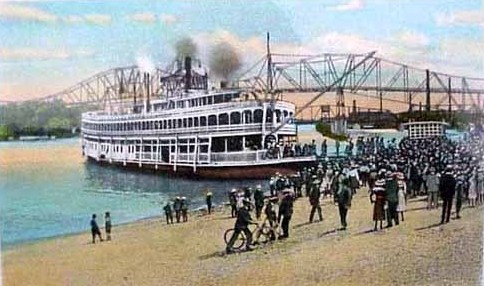 As a rule a farmer will not sell his oats, corn, pork, beef, poultry, eggs, hay,
straw, garden truck, etc., etc., in one town and then take the money received
for his produce into another town and spend it for necessaries. This may be done
in part where there are very large stocks of goods to select from, and where the
producer is satisfied it is to his advantage to occasionally buy a bill of
goods, but to make business lively and the deal square and straight on both
sides, the old time method of buying where you sell must come into vogue.
As a rule a farmer will not sell his oats, corn, pork, beef, poultry, eggs, hay,
straw, garden truck, etc., etc., in one town and then take the money received
for his produce into another town and spend it for necessaries. This may be done
in part where there are very large stocks of goods to select from, and where the
producer is satisfied it is to his advantage to occasionally buy a bill of
goods, but to make business lively and the deal square and straight on both
sides, the old time method of buying where you sell must come into vogue.
Now the bridge is open. Let the people from the other side of the river come and
see what advantages Clinton offers in the way of trader. They will find here
stocks of goods as large as similar houses carry in Chicago. They will find
enough competition here in every line of business to assure them the goods they
must have at fair and reasonable prices. Thousands of people in Illinois have
long since been cognizant of this fact, and have year after year patronized the
Clinton merchants. This number has been steadily growing. Now that facilities
for readily reaching here have been improved by a bridge which can be crossed at
any hour, day or night, rain or shine, summer and winter, a lower rates than the
ferry was compelled to charge to make expenses, the number will undoubtedly
increase with great rapidity. Let the farmers on both sides the river be given
to understand that they can find in Clinton, at all seasons of the year, a good
market for their produce. Not only a good market, but that they will always find
big stocks of goods of every description from which to make their selections.
Come and see for yourselves.
The Clinton Daily Herald, July 5, 1904
THE BRIDGE DAMAGED.
TWO SPANS DESTROYED BY THE STORM SUNDAY.
Wagon Bridge over the River Suffers From the Fury of the Tempest – 360 Feet of
Structure Goes Into The Mississippi.
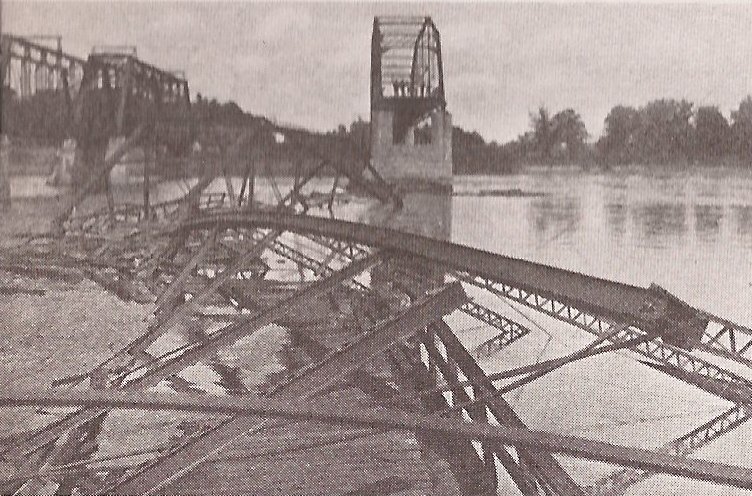 In the storm which struck the city and vicinity early Sunday evening, two spans
of the wagon bridge over the Mississippi were blown down by the wind, and the
high bridge is temporarily closed to traffic. Robert Barclay, watchman at the
east end of theNorthwestern railroad bridge, was the only eye witness to the
destruction of the two spans, which were located between Willow island and the
government raft channel, not far from the Illinois bank. He says the wind came
from the southwest, threshing the water into spray, accompanied by a torrential
rain. With a mighty lurch the two spans gave way, the caisson pier which
supported them sinking, and the platform was picked up by the wind and hurled
from 60 to 70 feet northeast, toward the railroad bridge, where it settled into
the water, a broken, twisted mass of iron and plank. A single span remains
standing over the raft channel on the other side of the river.
In the storm which struck the city and vicinity early Sunday evening, two spans
of the wagon bridge over the Mississippi were blown down by the wind, and the
high bridge is temporarily closed to traffic. Robert Barclay, watchman at the
east end of theNorthwestern railroad bridge, was the only eye witness to the
destruction of the two spans, which were located between Willow island and the
government raft channel, not far from the Illinois bank. He says the wind came
from the southwest, threshing the water into spray, accompanied by a torrential
rain. With a mighty lurch the two spans gave way, the caisson pier which
supported them sinking, and the platform was picked up by the wind and hurled
from 60 to 70 feet northeast, toward the railroad bridge, where it settled into
the water, a broken, twisted mass of iron and plank. A single span remains
standing over the raft channel on the other side of the river.
The spans were 150 and 210 feet in length, respectively, supported in the center
by a caisson pier, the two heavy iron cylinders of which enclosed piling and
concrete. The spans adjoining those wrecked, on the east and west, were not
damaged in the least, as was found yesterday on examination, the two spans which
were destroyed having been wrenched free from the other portions of the
structure by the impact of the wind. The water underneath is from 6 to 15 feet
in depth.
The bridge was at once closed, and will remain so for some time, while the
insurance companies adjust the insurance, and the work of replacing the spans is
carried out. The loss is about $10,000.
Hundreds of Clinton people went over to the spot Monday and today, to view the
evidences of the storm’s fury. Numbers of pictures of the wreck were secured.


